
Crotalus scutulatus is a highly venomous pit viper species found in the deserts of the southwestern United States and central Mexico. It is perhaps best known for its potent neurotoxic-hemotoxic venom, which is considered one of the world's most potent rattlesnake venoms. Two subspecies are recognized, including the nominate subspecies described here.

The black-tailed rattlesnake is a venomous pit viper species found in the southwestern United States and Mexico. Four subspecies are currently recognized, including the nominate subspecies described here.

Crotalus basiliscus is a venomous pit viper species in the family Viperidae. The species is endemic to western Mexico. The specific name, basiliscus, is derived from the Greek word for king, βασιλισκος, and alludes to this snake's large size and potent venom. There are no subspecies which are recognized as being valid.

Crotalus helleri is a highly venomous pit viper subspecies found in southwestern California and south into Baja California, Mexico.

Crotalus willardi is a venomous pit viper species found in the southwestern United States and Mexico. This snake is found mainly in the "sky island" region. The IUCN reports this snake's conservation status as being of Least Concern. It is the official state reptile of Arizona.

Crotalus ruber is a venomous pit viper species found in southwestern California in the United States and Baja California in Mexico. Three subspecies are currently recognized, including the nominate subspecies described here.

The western diamondback rattlesnake or Texas diamond-back is a venomous rattlesnake species and member of the Viper family, found in the southwestern United States and Mexico. It is likely responsible for the majority of snakebite fatalities in northern Mexico and the greatest number of snakebites in the U.S. No subspecies are currently recognized.

Crotalus viridis is a venomous pit viper species native to the western United States, southwestern Canada, and northern Mexico. Currently, two subspecies are recognized, including the prairie rattlesnake, the nominate subspecies, and the Hopi rattlesnake.

Crotalus mitchellii is a venomous pit viper species in the family Viperidae. The species is endemic to the Southwestern United States and adjacent northern Mexico. The species was named in honor of Silas Weir Mitchell (1829–1914), an American medical doctor who also studied rattlesnake venoms. Five subspecies are currently recognized, including the nominate subspecies described here.

Crotalus lepidus klauberi is a venomous pitviper subspecies endemic to the southwestern United States and adjacent northern Mexico.

Sistrurus catenatus tergeminus is a venomous pit viper subspecies found in the southwestern plains of the United States. In some areas its range overlaps that of another subspecies, S. c. edwardsii, and intergrading of the two is not unknown.

Crotalus unicolor is a venomous pitviper species found only on the Caribbean island of Aruba, off the coast of Venezuela. It is sometimes still classified as a subspecies of Crotalus durissus.

Crotalus oreganus, commonly known as the (northern) Pacific rattlesnake, is a venomous pit viper species found in western North America from the Baja California Peninsula to the southern interior of British Columbia.

The Great Basin rattlesnake is a venomous pit viper species found in the Great Basin region of the United States.
Crotalus intermedius omiltemanus is a venomous pitviper subspecies found in Mexico in the state of Guerrero.

Crotalus pricei is a species of venomous snake, a pit viper in the family Viperidae. The species is endemic to the southwestern United States and northern Mexico. Two subspecies are recognized.

Crotalus concolor is a venomous pit viper species found in the western United States. It is a small rattlesnake known for its faded color pattern. Other common names include midget faded rattlesnake, faded rattlesnake and yellow rattlesnake.

Crotalus cerberus is a venomous pit viper species found in the southwestern United States. It is known as the Arizona black rattlesnake, black rattlesnake, and several other common names.

Crotalus pyrrhus is a venomous pitviper species found in the southwestern United States and northwestern Mexico. A medium-sized snake, it is found mostly in rocky country, active at night and feeding on small mammals. The coloration is variable and depends on the color of the rocks and soil of the habitat.
The Sierra San Luis range is a mountain range in northwest Chihuahua, northeast Sonora, Mexico at the northern region of the Sierra Madre Occidental cordillera. The region contains sky island mountain ranges, called the Madrean Sky Islands, some separated from the Sierra Madre Occidental proper, and occurring in the northeastern Sonoran Desert, and extreme west-northwestern Chihuahuan Desert. Many of the ranges occur in southeast Arizona.



















